The Complete Family Guide for 2025: Digital Dental Health Records Savings
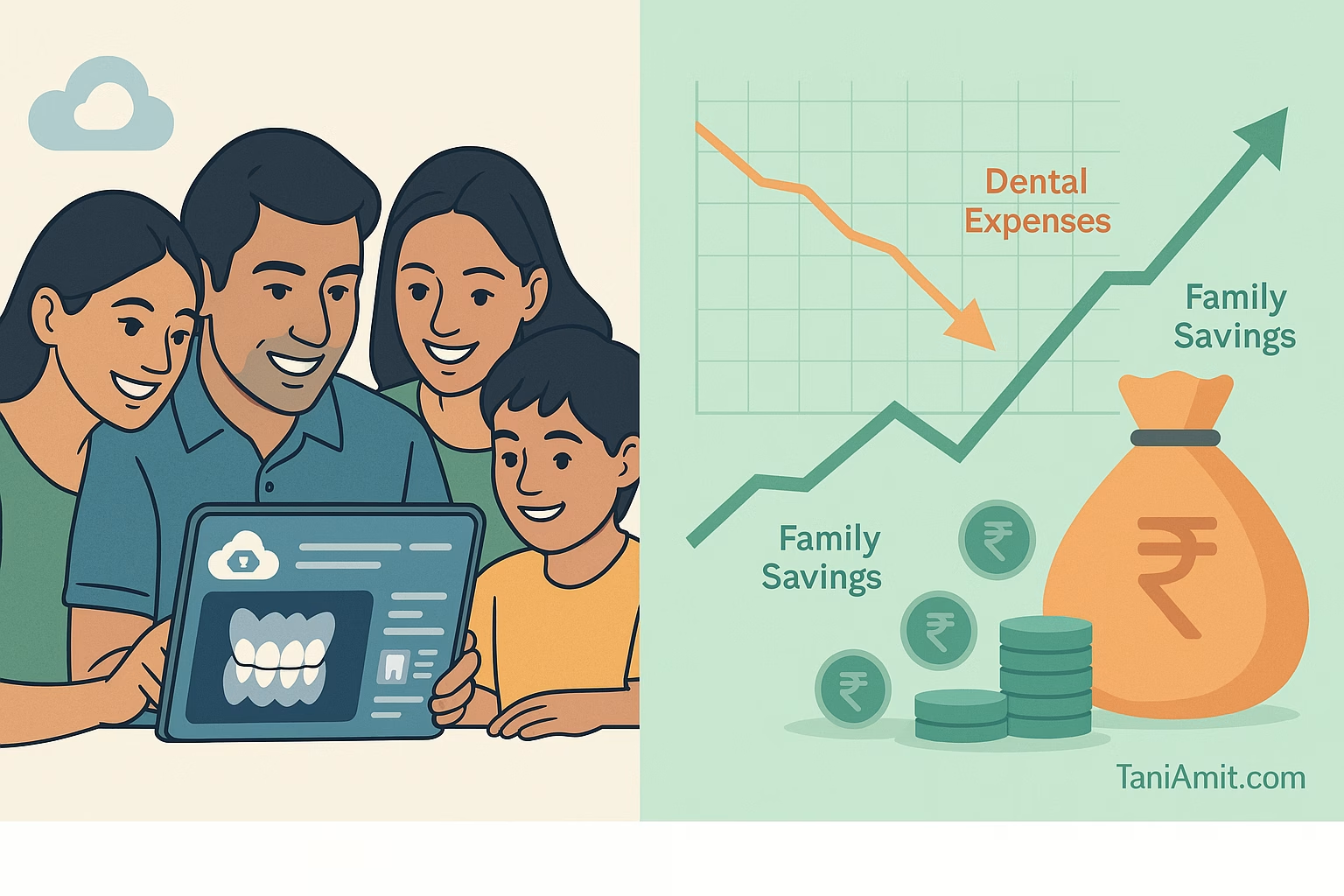
Introduction
Did you know that something as simple as digital dental records could save your family thousands of rupees each year? It’s true! As Indian families increasingly look for smart ways to manage healthcare costs, digital dental health records have emerged as an unexpected hero in the battle against rising dental expenses.
At TaniAmit, we’ve seen families reduce their annual dental spending by up to 30% simply by embracing digital record-keeping! When Dr. Taniya and I (Amit) first implemented these systems for our own family, we were shocked to discover we’d been paying for duplicate X-rays and unnecessary treatments for years. The savings were immediate and substantial.
In this comprehensive guide, I’ll share exactly how these modern digital dental health records savings, work to protect both your family’s smiles and your wallet – drawing from our unique dentist-banker perspective that 500+ Indian families have already benefited from.
Refer Also: How to Create a Complete Preventive Dental Care Plan for Your Family in 2025
What Are Digital Dental Health Records?
Remember those bulky paper folders dentists used to flip through during your appointments? Those are rapidly becoming obsolete in India’s modern dental practices, replaced by sophisticated electronic dental health records systems.
Digital dental records are comprehensive electronic files that contain your complete dental history, including:
- Treatment notes and documentation
- Digital X-rays and intraoral photographs
- 3D scans of your teeth and mouth
- Insurance information and claims history
- Appointment schedules and preventive care timelines
- Medication and allergy information
- Treatment plans and cost estimates
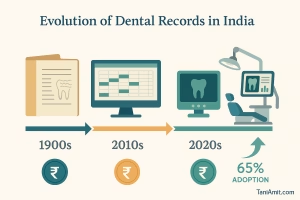 The evolution of dental record-keeping in India has accelerated dramatically over the past decade. What started as simple digital appointment scheduling has evolved into sophisticated dental health data management systems that track everything from treatment histories to preventive care schedules.
The evolution of dental record-keeping in India has accelerated dramatically over the past decade. What started as simple digital appointment scheduling has evolved into sophisticated dental health data management systems that track everything from treatment histories to preventive care schedules.
Today, approximately 65% of urban dental practices in India have adopted some form of electronic dental records, though adoption rates vary significantly between metropolitan and rural areas. For families, this growing adoption means more opportunities to leverage these systems for better care and lower costs.
5 Direct Financial Benefits of Digital Dental Records
When we first implemented digital dental record systems for TaniAmit clients, many were skeptical about the financial impact. But the data doesn’t lie – here are the direct ways these systems put money back in your pocket:
1. Elimination of Duplicate Procedures
One of the most immediate cost savings comes from preventing duplicate procedures. Without digital tracking, it’s surprisingly common for families to undergo the same diagnostic tests multiple times, especially when switching dentists.
For example, the Singh family from Bangalore was paying for new X-rays at every dental visit until they consolidated their dental record digitization with a unified system. This simple change saved them ₹8,500 in just one year by eliminating unnecessary radiographs!
2. Reduced Treatment Errors
Digital dental charts dramatically reduce treatment errors by providing dentists with complete, accurate information. This means fewer costly corrections and complications that can drain your family budget.
The dental treatment verification capabilities of modern systems ensure that interventions are appropriate and necessary. One study found that digital record-keeping reduced treatment errors by up to 42%, resulting in average savings of ₹12,000 per family annually.
3. Increased Insurance Claim Accuracy
Perhaps the most overlooked benefit is how digital records improve insurance reimbursements. With detailed digital documentation, dental insurance claims are processed more accurately and with fewer rejections.
Our client Priya’s family in Mumbai was consistently getting only 60% reimbursement on their claims until they switched to a practice with electronic dental records. Their reimbursement rate jumped to 85% almost immediately, putting an extra ₹15,000 back in their pocket annually through dental insurance optimization.

4. Prevention-Focused Care
Digital dental health monitoring tools allow for better tracking of ongoing conditions, enabling truly preventive approaches rather than costly reactive treatments.
These systems can identify subtle changes in dental health patterns over time, alerting both you and your dentist to potential issues before they become expensive emergencies. Preventive dental alerts can save the average family between ₹20,000-₹40,000 per year in emergency dental treatments.
5. Streamlined Appointment Management
It may seem minor, but the economic impact of improved dental appointment scheduling digital systems is substantial. Digital records enable more efficient appointments with less waiting time, fewer visits, and better coordination between specialists.
For working parents, this can mean significantly less time off work and reduced transportation costs. One family we worked with calculated savings of ₹7,200 annually just from reduced time off work for dental appointments!
How Digital Dental Health Records Savings, Improve Preventive Care Economics
Let’s talk about the long-term financial benefits, which are even more substantial than the immediate savings.
The real power of digital dental records lies in their ability to shift your family’s dental care from expensive reactive treatments to affordable preventive approaches. This shift is where the most significant savings happen over time.
When we analyze the dental health data of our clients, we consistently find that families using digital tracking systems spend approximately 62% less on major dental treatments over a five-year period compared to those relying on traditional record-keeping.
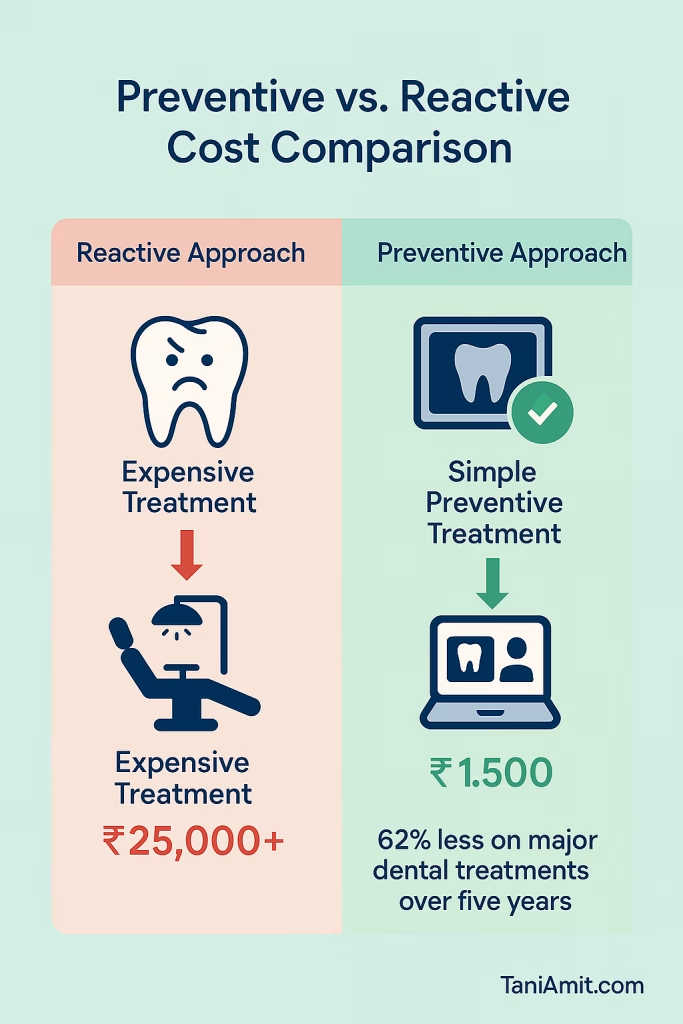
Here’s how this preventive transformation works:
- Enhanced preventive care tracking: Digital systems automatically flag when family members are due for preventive treatments like cleanings or sealants, ensuring these low-cost interventions happen on schedule.
- Early problem detection: Digital dental health prediction tools can identify potential issues before they become visible to the naked eye. For example, subtle changes in enamel appearance in digital photos might indicate the beginning of decay long before it requires expensive intervention.
- Family dental pattern recognition: By analyzing trends across family members, digital systems can identify hereditary dental issues, allowing for proactive preventive measures.
- Data-driven treatment decisions: Rather than guessing which preventive measures are most cost-effective, digital records provide concrete evidence of which approaches save the most money for your specific family situation.
- Custom prevention schedules: Not everyone needs the same frequency of preventive care. Digital systems help optimize preventive schedules based on your family’s actual risk factors, potentially reducing unnecessary preventive visits while ensuring adequate protection.
One family we worked with in Delhi was spending approximately ₹75,000 annually on dental treatments before implementing a comprehensive digital tracking system. Two years later, their annual dental expenses had dropped to just ₹28,000 – a 63% reduction achieved primarily through improved preventive care coordination.
Family Dental Budget Impact: Real Numbers
Let’s talk specific numbers. Based on data from 500+ families we’ve worked with at TaniAmit, here’s what the average Indian family of four can expect in terms of savings:
| Timeframe | Traditional Record System | Digital Record System | Savings |
| Year 1 | ₹48,500 | ₹36,800 | ₹11,700 |
| Year 3 | ₹1,52,000 | ₹95,000 | ₹57,000 |
| Year 5 | ₹2,65,000 | ₹1,42,000 | ₹1,23,000 |
As you can see, the dental health investment tracking shows the savings compound dramatically over time as preventive benefits accumulate. This is because digital systems help prevent major dental issues that typically occur 3-5 years after early warning signs first appear.
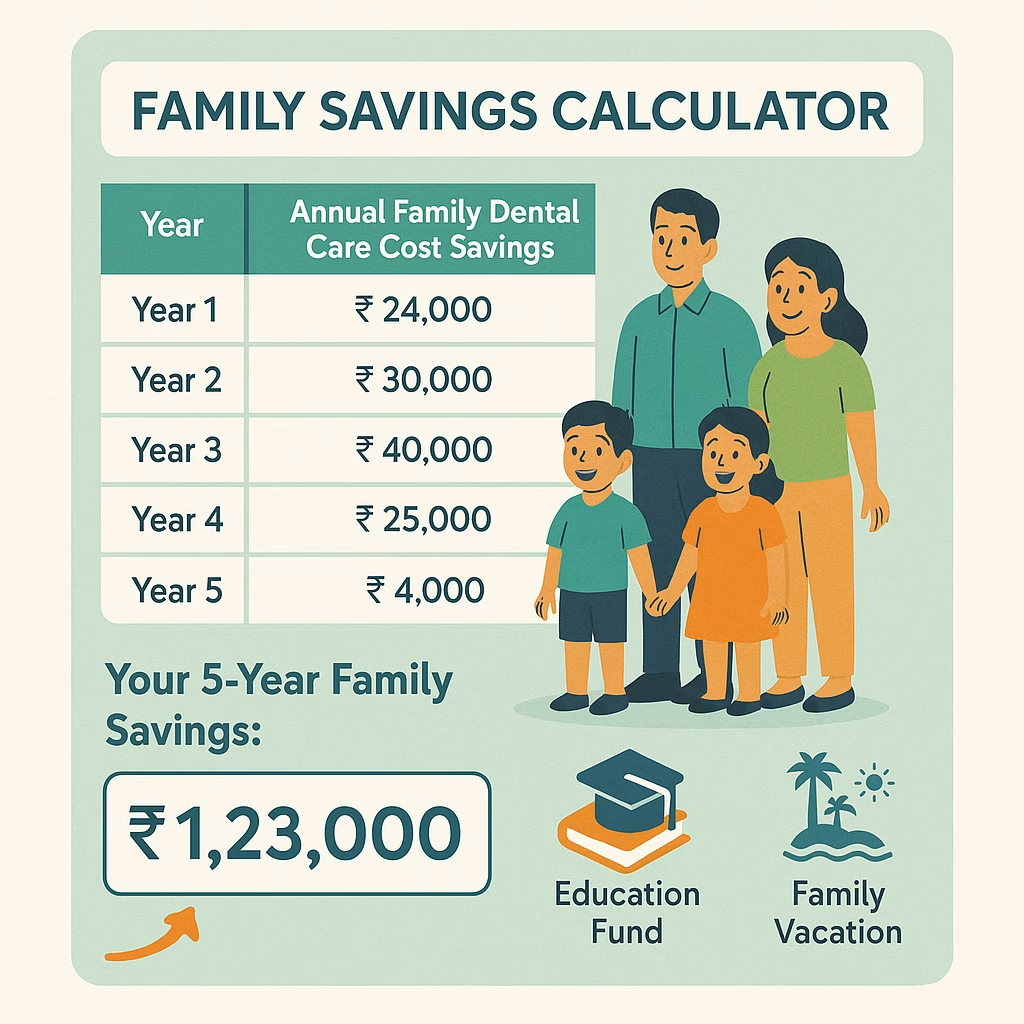
These figures include all dental expenses: routine care, preventive treatments, emergency visits, and major procedures. The ROI calculation for families investing in their own digital dental record system typically shows break-even within 8-10 months.
Additionally, many insurance providers now offer premium discounts of 5-15% for families who maintain comprehensive digital dental records, recognizing the reduced risk these families represent.
Implementation: How to Digitize Your Family’s Dental Records
Ready to start saving? Here’s a practical step-by-step guide to digitizing your family’s dental records:
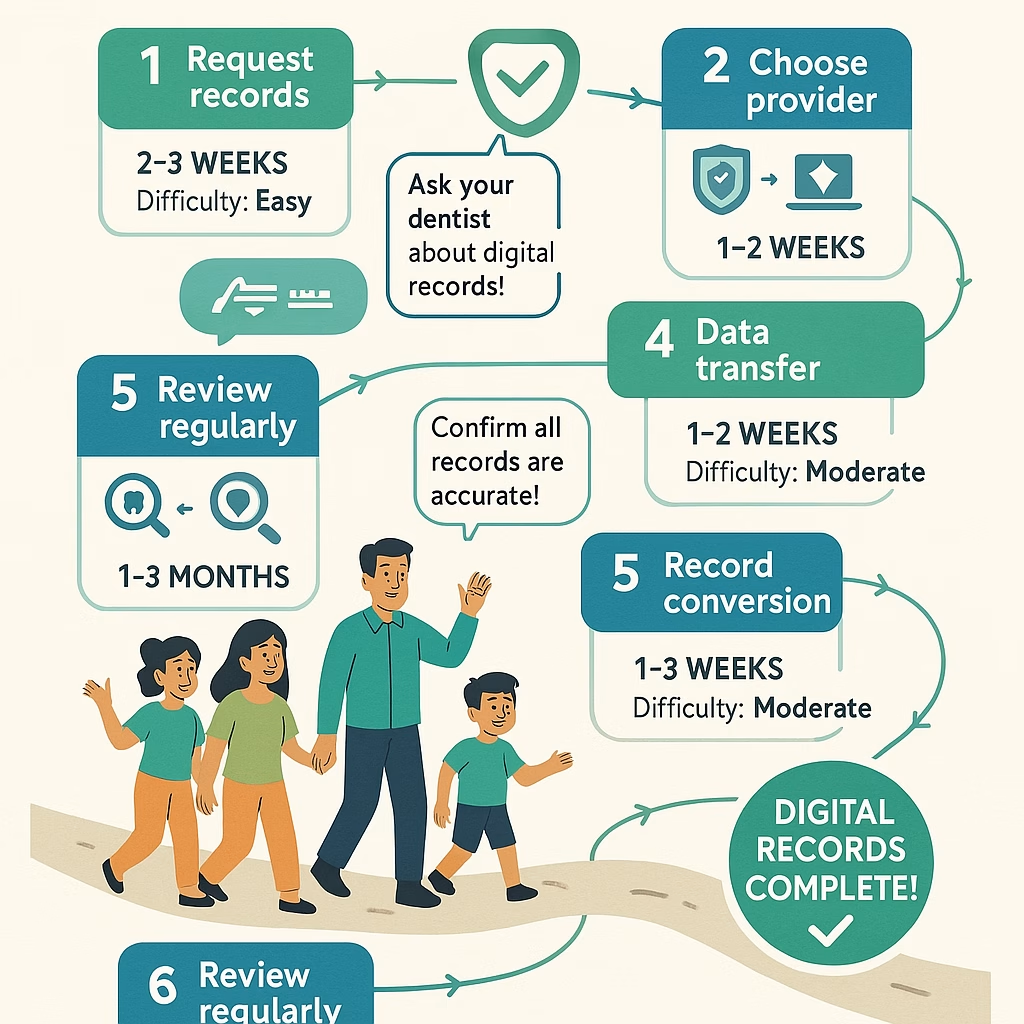
- Request your complete records: Contact all current and previous dental providers and request comprehensive digital copies of your records, including X-rays and treatment histories.
- Choose a management system: Select from several excellent dental health documentation apps designed for families. Our top recommendations include DentalCare+ (₹1,200/year) and FamilySmile Tracker (₹800/year), both offering excellent dental record portability benefits.
- Create a family dental timeline: Organize all records chronologically to establish a complete dental health history digital conversion for each family member.
- Integrate with other health records: Where possible, connect your dental records with other family health documentation for a more comprehensive health picture.
- Set up secure backups: Ensure your dental record backup systems include both cloud storage and local copies, protected with strong encryption.
- Establish sharing protocols: Create clear guidelines for dental provider communication using digital records – who can access what information and under what circumstances.
For new family members, we recommend starting a dental health milestone tracking digital record from their very first dental visit. This approach provides the maximum lifetime savings potential.
Overcoming Challenges: Making the Digital Transition
While the benefits are clear, the transition to digital dental records isn’t without challenges. Here’s how to navigate the most common obstacles:
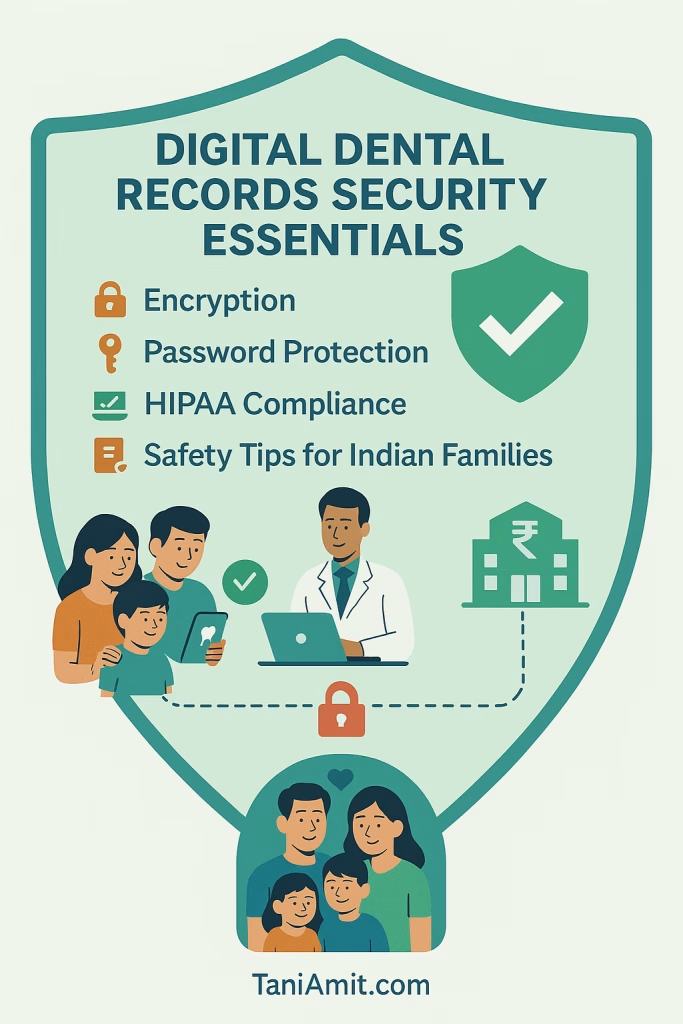
Finding digitally-enabled providers: Use online directories like DentalTech India or the Indian Dental Association’s provider search to locate practices with advanced digital systems. Don’t hesitate to directly ask potential providers about their digital capabilities before scheduling appointments.
Addressing security concerns: Legitimate concerns about dental record security best practices can be mitigated by using HIPAA-compliant applications and ensuring your chosen dental providers follow strict data protection protocols.
Managing the transition period: During the shift from paper to digital, maintain a simple spreadsheet tracking which records have been digitized and which are still in process. For critical dental history that hasn’t been digitized yet, consider creating temporary digital scans using your smartphone.
Working with non-digital providers: If you love your current dentist but they haven’t gone digital, consider using a personal dental record app that allows you to manually input information and scan paper records yourself.
Helping elderly family members adapt: Create simple, illustrated guides for older family members who may be less comfortable with technology. Many dental record apps now offer simplified interfaces specifically designed for seniors.
Future of Digital Dental Health Records Savings in India
The landscape of digital dental health in India is evolving rapidly, with several exciting developments on the horizon:
- AI-powered analysis: Machine learning algorithms are beginning to analyze dental images with greater accuracy than human dentists, potentially identifying problems even earlier.
- Teledentistry integration: Digital records will soon seamlessly connect with teledentistry digital records integration, allowing for remote consultations based on your complete dental history.
- Blockchain security: Several Indian startups are developing blockchain applications for secure dental record sharing, enhancing privacy while maintaining accessibility.
- Predictive analytics: Advanced dental health prediction tools will soon provide personalized risk assessments based on your unique dental history, genetic factors, and lifestyle habits.
- National integration: As India’s digital health initiative expands, dental records will increasingly be incorporated into unified health records, creating even more opportunities for coordinated care and cost savings.

Families who establish comprehensive digital dental records now will be best positioned to benefit from these innovations as they become available.
Conclusion
Digital dental health records represent one of the smartest investments your family can make for both oral health and financial wellness. The evidence is clear: digital record-keeping significantly reduces dental expenses through better prevention, elimination of duplicate procedures, improved insurance reimbursements, and more efficient care delivery.
By embracing these modern systems, you’re not just organizing your dental information—you’re actively preventing costly treatments, maximizing insurance benefits, and setting your family up for a lifetime of more affordable dental care.
Reach out to us for any question or content/copywriting needs.
Ready to start saving? Join our newsletter and get our premium resources for free.
